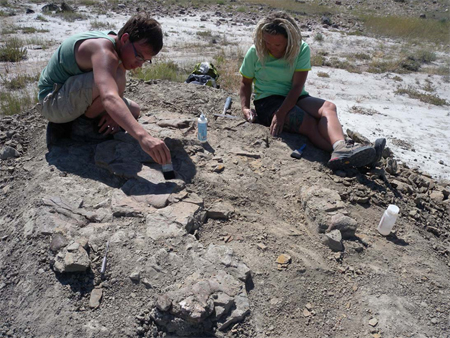From the Field: Southern Alberta Dinosaur Project 2011 – Cherry on top
July 13-14, 2011
We have been in the field for almost a month. The last few days we have been winding down the field season. We have been getting the exposed and mapped bones out of the quarries before shutting them down. We finished off the McPheeters Bonebed yesterday. We did incredibly well here this season, thanks to the hard work and dedication of ROM tech Ian Morrison and student Kentaro Chiba. In total, we collected over 230 bones from the site, including approximately 80 plaster field jackets. This year’s collection includes a wealth of skull bones, and most importantly a very nice growth series of both the humerus and femur, the upper bones of the fore and hind limb, respectively. This material will form the core of a grad student project on growth, population structure, and variation in Centrosaurus.
We closed the South Side Ceratopsian quarry the day before last. We got out all of the bones that we uncovered, and as we were trenching the last blocks, we found more bones going into the hill. We still need to find the rest of the frill as well as the brow horns in terms of the skull, and we hope that more limb bones are still waiting just into the hill. This will be a prime objective for next, as it is the first associated skeleton of a ceratopsian dinosaur from the lower unit of the Oldman Formation, and our very preliminary observations in the field suggest that we might have new species on our hands.

Working to uncover the partial skull.
Today was supposed to be a half-day in the field for a small crew, while the rest of the group began to tear down camp for the season. We decided to try to find the quarry site of a juvenile duck-billed dinosaur in the Manyberries pocket area- which has exposure of the marine Bearpaw Formation and the fossiliferous Dinosaur Park Formation. We failed to find the quarry, but we did end up making one last lucky strike; while prospecting a very small outcrop of Dinosaur Park Formation, I found a few fragments that looked like they belonged to a ceratopsian skull on a small bench of mudstone. I started to expose the surface of one of the eroding bones, and in five minutes I had an almost perfect ceratopsian quadrate bone of the skull. With a bit more digging around, we had uncovered an excellent preserved partial Chasmosaurus skull! Chasmosaurs are horned dinosaurs that have very large frills, and they are relatively rare in Alberta. We worked quickly, and got the specimen out just before dinnertime. What a great way to cap off one of our best seasons in southern Alberta yet, and a season that has turned out to be our Year of the Ceratopsian.
